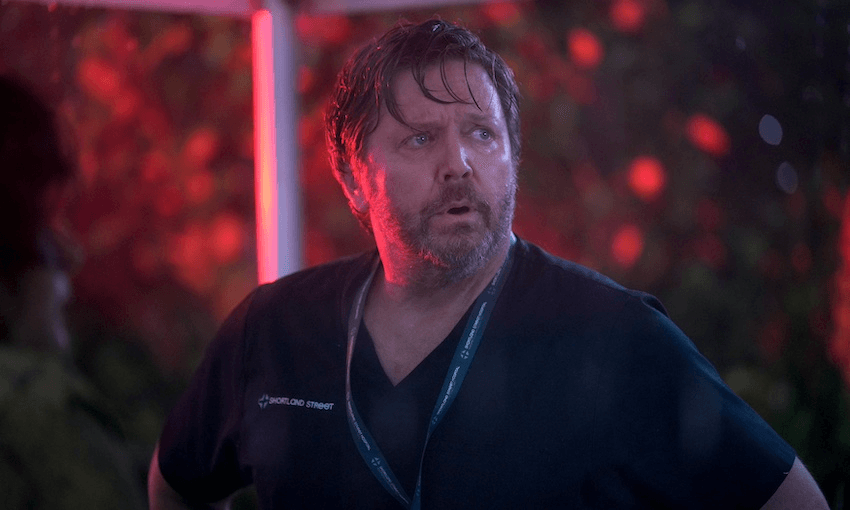In episode two of Get It to Te Papa, a Lightbox Original made by The Spinoff, Hayden Donnell goes in search of the animatronic veges that instilled both delight and horror in ’90s kids across the nation.
Watch Get It to Te Papa on Lightbox here.
My memories of the Big Fresh Animatronic Fruit and Veges are fragmentary at best. I have foggy visions of huge, swaying food sentinels peering down as my mum made a beeline for the free bread rolls inside Glenfield Big Fresh. But the feeling of seeing them remains as vivid and piercing as it was 20 years ago. Every time I beheld what I now know to be the “Goodness Family”, I was overcome by stomach-churning mixture of awe, wonder, and existential terror.
Why though? The Goodness Family’s impact was probably heightened by another sight that haunted me in my youth. I remember watching an old cartoon where a talking apple was captured by baddies who tied him to a log of wood, which they then set to rotating above a fire.
The scene was played for laughs. The apple was quipping as he cooked. I couldn’t understand his mirth. My young mind returned over and over to the pain he must have been in, slowly roasting above that open fire, licked again and again by tendrils of flame and yet refusing to die.
This character may have been an apple, but he had human characteristics. Surely he would feel as we would.
As comedian Angella Dravid told me, encountering the Big Fresh Animatronic Fruit and Veges felt similar to seeing a dental ad featuring “teeth with teeth”. In the minds of most adults, teeth with teeth are throwaway fun. But to Angella, they’re the sick court jesters of the dental realm; freakshows no different to a human with a mouth full of humans. Their sentience is a curse.
Were the Big Fresh Animatronic Fruit and Veges so unlike a tooth with teeth, or a humanoid apple that remains unburned? Their mouths were set to perma-grin; their gigantic bright bodies constantly swayed to the sound of upbeat country music. But their unearthly happiness felt unnatural and unearned, untethered to the terrible reality of their situation.
Former Big Fresh employee Kerryanne Nelson told me the Big Fresh Animatronic Fruit and Veges were often left on at night. Employees would arrive in the morning to the fruit and veges’ watching down with unblinking smiles, having creaked side to side for hours in the sterile dark.
If those fruit and veges could’ve found a way to break their endless inanimate silence to speak to those early morning workers, what would they have whispered: “I’m happy to face another day”, or “kill me now”?
These horrors would never pass through the mind of an adult, numbed as we are to the grotesqueries of commerce, and they would never be able to be truly articulated by a child. But children are not yet trained to ignore and dismiss the commonplace weirdness of life. And so I believe we who were children in that very short era of New Zealand history – the ’90s – saw the Big Fresh Animatronic Fruit and Veges in a way no older person from that time could. It was a sight that left us forever changed.
Related:
Remembering Big Fresh, New Zealand’s greatest supermarket of all time
The thing is, the people who made the Big Fresh Animatronic Fruit and Veges never intended any of this. Bill Harris, who designed them, saw them as a bit of fun – a marketing gimmick that caught on for a few years. He loved them, but they couldn’t speak to him on the same level they did 12-year-old me.
The people who own them now appreciate them for reasons mostly divorced from their history. Nicole Stewart, the co-owner of Auckland second-hand store Junk and Disorderly, rightly views her pristine set of Big Fresh Animatronic Fruit and Veges as amazing collectors items. But she doesn’t pick up on their emotional resonance in the same way someone who entered Big Fresh as a child would.
Anthony Blundell cares for his set Big Fresh Animatronic Fruit and Veges on a wavelength comparable to mine. But his affection for them is based on what they mean to him today rather than what they meant decades ago. The full set of Big Fresh Animatronic Fruit and Veges sitting atop Blundell’s business, Kaipara Kumara, have become beloved landmarks in his small hometown, Ruawai. They’re tourist attractions, and a source of pride for local kids. Separated from their original context by decades and distance, they still have a special power. Blundell calls them Wows, because that’s what people say when they see them for the first time.
Maybe his is the most authentic use of the Big Fresh Animatronic Fruit and Veges today. The Wows, as they’re now known, are a portal back to a more innocent time, when bread rolls could be free, and supermarkets could inspire all the emotions of a carnival ride. Sometimes that was fear, sometimes happiness, but no matter what, it was always special and memorable.
I will always be grateful to Blundell for loaning us one of his prized Wows. We spent $2000 shipping the Big Fresh Animatronic mushroom to Te Papa – a hugely disproportionate amount of our show’s budget, and possibly more than our director José was paid in total. It was worth every penny.
Read more about Get It to Te Papa and its genesis in Hayden Donnell’s brain right here.
Get It to Te Papa is a Lightbox Original, made by The Spinoff. Episodes 1 and 2 premiere on October 16th at midday on Lightbox.



